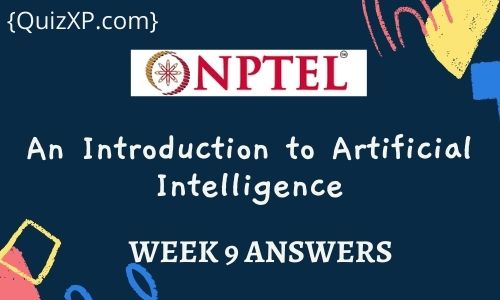Are you looking for the Answers to NPTEL An Introduction to Artificial Intelligence Assignment 9 – IIT Delhi? This article will help you with the answer to the National Programme on Technology Enhanced Learning (NPTEL) Course “NPTEL An Introduction to Artificial Intelligence Assignment 9 “
What is An Introduction to Artificial Intelligence?
An Introduction to Artificial Intelligence by IIT Delhi course introduces the variety of concepts in the field of artificial intelligence. It discusses the philosophy of AI, and how to model a new problem as an AI problem. It describes a variety of models such as search, logic, Bayes nets, and MDPs, which can be used to model a new problem. It also teaches many first algorithms to solve each formulation. The course prepares a student to take a variety of focused, advanced courses in various subfields of AI.
CRITERIA TO GET A CERTIFICATE
Average assignment score = 25% of the average of best 8 assignments out of the total 12 assignments given in the course.
Exam score = 75% of the proctored certification exam score out of 100
Final score = Average assignment score + Exam score
YOU WILL BE ELIGIBLE FOR A CERTIFICATE ONLY IF THE AVERAGE ASSIGNMENT SCORE >=10/25 AND EXAM SCORE >= 30/75. If one of the 2 criteria is not met, you will not get the certificate even if the Final score >= 40/100.
Below you can find the answers for NPTEL An Introduction to Artificial Intelligence Assignment 9
| Assignment No. | Answers |
|---|---|
| An Introduction to Artificial Intelligence Assignment 1 | Click Here |
| An Introduction to Artificial Intelligence Assignment 2 | Click Here |
| An Introduction to Artificial Intelligence Assignment 3 | Click Here |
| An Introduction to Artificial Intelligence Assignment 4 | Click Here |
| An Introduction to Artificial Intelligence Assignment 5 | Click Here |
| An Introduction to Artificial Intelligence Assignment 6 | Click Here |
| An Introduction to Artificial Intelligence Assignment 7 | Click Here |
| An Introduction to Artificial Intelligence Assignment 8 | Click Here |
NPTEL An Introduction to Artificial Intelligence Assignment 9 Answers:-
Q1. Which of the following is true about the MAP (Maximum a posteriori estimate) estimation learning framework?
a. It is equivalent to Maximum Likelihood learning with infinite data
b. It is equivalent to Maximum Likelihood learning if P(θ) is independent of θ
c. it can be used without having any prior knowledge about the parameters
d. The performance of MAP is better with dense data compared to sparse data
Answer:- a,d
Note :- I am not 100% sure about these answers please do it on your own knowledge
Q2. What facts are true about smoothing?
- Smoothed estimates of probabilities fit the evidence better than un-smoothed estimates.
- The process of smoothing can be viewed as imposing a prior distribution over the set of parameters.
- Smoothing allows us to account for data which wasn’t seen in the evidence.
- Smoothing is a form of regularization which prevents overfitting in Bayesian networks.
Answer: a,c
Q3. Consider three boolean variables X, Y, and Z. Consider the following data:
There can be multiple Bayesian networks that can be used to model such a universe. Assume that we assume a Bayesian Network as shown below:
If the value of the parameter P(¬z|x,¬y) is m/n such that m and n have no common factors. Then, what is the value of m+n? Assume add-one smoothing.
Answer: 343.6
Q4. Consider the following Bayesian Network from which we wish to compute P(x|z) using rejection sampling:
Answer: 86.9
Q5. Assume that we toss a biased coin with heads probability p, 100 times. We get heads 66 times out of 100. If the Maximum Likelihood estimate of the parameter p is m/n where m and n don’t have common factors,
then the value of m+n is?
Answer: 77
Q6. Now, assume that we had a prior distribution over p as shown below:
Answer:- 6.5
Q7. Which of the following task(s) are not suited for a goal based agent?
Answer: b,c
Q8. Which of the following are true ?
- Rejection sampling is very wasteful when the probability of getting the evidence in the samples is very low.
- We perform conditional probability weighting on the samples while doing Gibbs Sampling in MCMC algorithm since we have already fixed the evidence variables.
- We perform random walk while sampling variables in Likelihood Weighting, MCMC with Gibbs sampling, but not in Rejection sampling.
- Likelihood Weighting functions well if we have many evidence wars with some samples having nearly all the total weight
Answer: a
Q9. Consider the following Bayesian Network:
- P(C|A,B,D,F,E) = α. P(C|A). P(C|B)
- P(C|A,B,D,F,E) = α. P(C|A,B)
- P(C|A,B,D,F,E) = α. P(C|A,B). P(D|C,E)
- P(C|A,B,D,F,E) = α. P(C|A,B,D,E)
Answer: b,c
Q10. Which of the following options are correct about the environment of Tic Tac Toe?
- Fully observable
- Stochastic
- Continuous
- Static
Answer: a,c
For other courses answers:- Visit
For Internship and job updates:- Visit
Disclaimer: We do not claim 100% surety of answers, these answers are based on our sole knowledge, and by posting these answers we are just trying to help students, so we urge do your assignment on your own.
if you have any suggestions then comment below or contact us at [email protected]
If you found this article Interesting and helpful, don’t forget to share it with your friends to get this information.
NPTEL An Introduction to Artificial Intelligence Assignment 9 Answers 2022:- All the Answers provided here to help the students as a reference, You must submit your assignment at your own knowledge.


